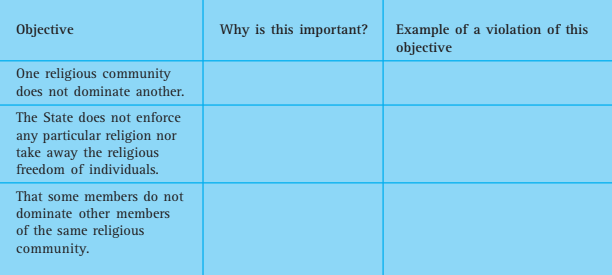NCERT Solutions for Class 8 Social Studies Civics Chapter 2 Understanding Secularism
Exercises
Question:- 1. List the different types of religious practice that you find in your neighbourhood. This could be different forms of prayer, worship of different gods, sacred sites, different kinds of religious music and singing etc. Does this indicate freedom of religious practice?
Answer:- Different types of religious practice in our neighbourhood are:-
(i) Jagran
(ii) Kirtan
(iii) Namaj
(iv) Langar distribution
(v) Havan
Yes, this indicates freedom of religious practice,that Indians have the freedom to practise whichever religion they want while still living in peace and love.
Question:- 2. Will the government intervene if some religious group says that their religion allows them to practise infanticide? Give reasons for your answer.
Answer:- If a religious group says that their religion allows infanticide, the government will undoubtedly intervene into it. This is because the Indian Constitution specifically states that if social peace is threatened, the government has the power to intervene. It needs to be noted that infanticide is a heinous crime. A newly born child’s life is taken in this ritual. Hence the law will surely forbids here.
Question:- 3. Complete the following table:-

Answer:-
Objective | Why is this important? | Example of a violation of this objective |
One religious community does not dominate another | It is important for maintaining harmony in the country. | prohibiting people of some religion from celebrating their festival. |
The State does not enforce any particular religion nor take away the religious freedom of individuals. | It is important so that everyone can follow religion of their choice. | India is a country where people of many castes and religions live together. |
That some members do not dominate other members of the same religious community | It is important for maintaining the equality among all. | Separating upper-class and lower-class people. |
Question:- 4. Look up the annual calendar of holidays of your school. How many of them pertain to different religions? What does this indicate?
Answer:- Our school’s annual calendar includes holidays such as Muslim’s festival Eid al-Fitr and Eid al-Adha, Hindu’s festivals like Holi and Diwali, Christmas of Christian, and Guru Nanak Jayanti for Sikh. This shows that India is a secular country in which everyone has the right to religious freedom.
Question:- 5. Find out some examples of different views within the same religion.
Answer:- Even within the same religion, different viewpoints are maintained. For example, there are hundreds of deities worshipped by various groups of people in the Hindu religion alone. Similarly, there are Shiyas and Shunnis in the Muslim community. Shwetambar and Digambar sects exist among Jainas. There are Hinayaans and Mahayaans in Buddha Dharma too.
Question:- 6. The Indian State both keeps away from religion as well as intervenes in religion. This idea can be quite confusing. Discuss this once again in class using examples from the chapter as well as those that you might have come up with.
Answer:- The Indian government both avoids and intervenes in religious matters. If a person from a majority religious group gains official power, he may utilise it to discriminate against and oppress people of other religions. The majority may even deny the minority the right to practise their faith. Untouchability, for example, still persists in the Hindu community. If the government is handed over to a person from an upper-caste Hindu majority, he may use it as a weapon against the society’s or state’s lower-class citizens.
Question:- 7. This poster alongside highlights the need for ‘Peace’. It says, “Peace is a never-ending process….It cannot ignore our differences or overlook our common interests.” Write in your own words what you think the above sentences are trying to convey? How does it relate to the need for religious tolerance?
This chapter had three drawings on religious tolerance made by students of your age. Design your own poster on religious tolerance for your peers.
Answer:- Do it Yourself